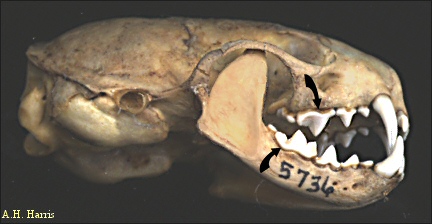

If you have ever looked into the mouth of a dog, you may have noticed that it has four kinds of teeth. There are incisors in the very front of the mouth, a long sharp canine tooth, four pointed premolars, and finally large molars in the back. Two pairs of the teeth, the fourth upper premolar and the first lower molar, are much larger than the others and are blade-like. When a dog closes its mouth, these teeth shear against each other like a pair of scissors. These are the carnassial teeth, and they are found only in the taxonomic order Carnivora.
This group of mammals not only includes the familiar meat-eating dog,
cat, hyena, and bear families, but also the weasels, raccoons, mongooses, and civets.
The presence of these teeth shows that these animals have all descended from a common
ancestor, even though the exact shape of the carnassials depends on the typical diet of
a species.

Contributor: Angela Chavez, Student, Museum Studies Class, Centennial Museum, University of Texas at El Paso.
Desert Diary is a joint production of the Centennial Museum and KTEP National Public Radio at the University of Texas at El Paso.

Skull of a Long-tailed Weasel (Mustela frenata). The arrows point to the upper 4th premolar and the 1st lower molar, the carnassial pair. Scanned UTEP specimen.
If you count the teeth in the image, it doesn't look like the 4th upper premolar and the first lower molar. This is because mammalogists keep count as though evolutionarily lost teeth were still present. Thus in the weasel, for example, the first upper premolar has been lost during its evolution, but the carnassial is still counted as number 4.